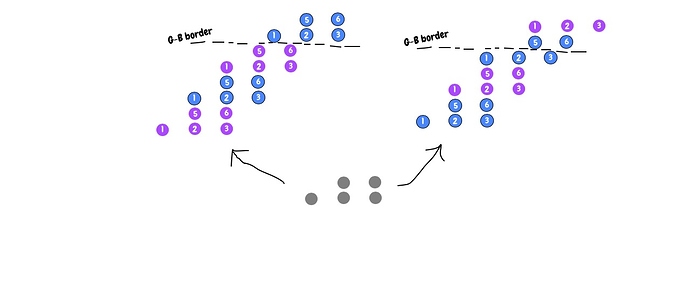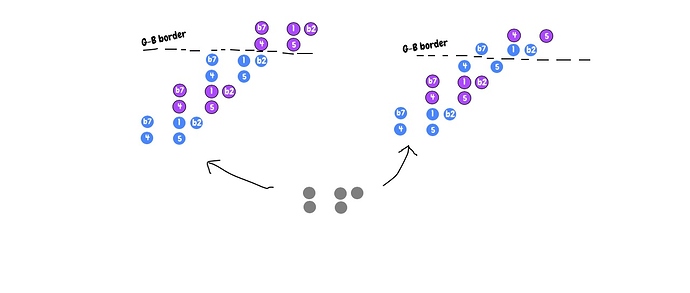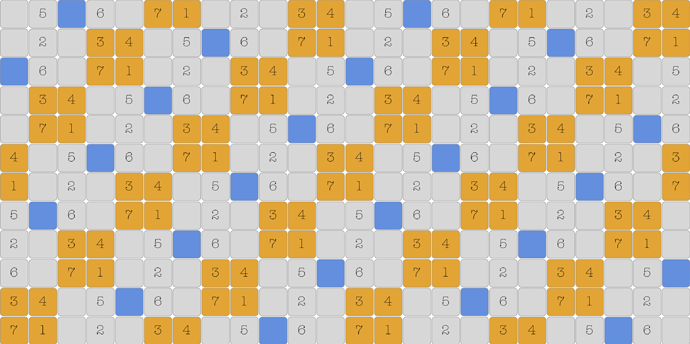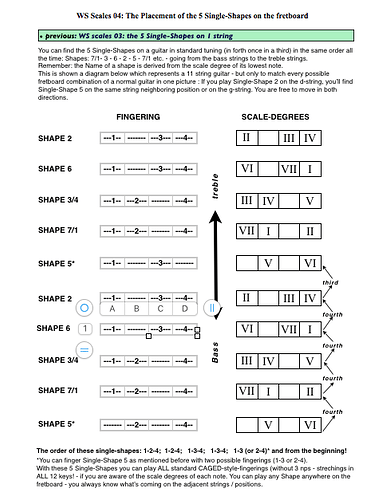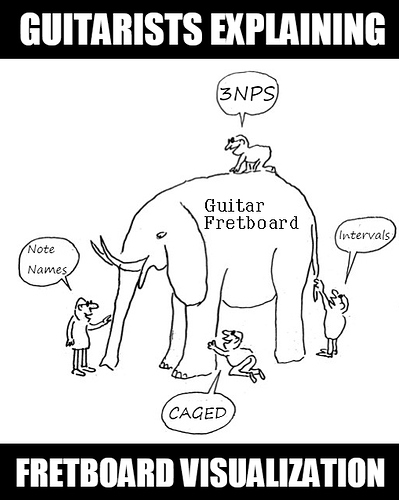This is very cool to note.
And hopefully the numbers are making more sense? I don’t know who did this drawing. I drew hundreds of similar ones playing with it back in the day, and again would like to note that they don’t have to stack up in the familiar three-note per string arrangement.
So as to not dominate this topic, I moved my FordScales discussion to a separate thread. @patternblue, I’d still be very interested to know who else was teaching this way? Are you the blue pattern? I kind of expected that in the age of finger controllers and readily accessible videos by tuned-in-fourths folks like Tom Quayle that I’d have seen someone charting stuff out this way too by now.
I’ll throw it out there that Derryl Gabel’s got some very interesting ways of organizing pentatonics. (And as always he’s a fantastic resource on Holdsworthian approaches and tone as well.)
And while thinking about @AGTG’s synthetic scale, I was reminded of scale systems that vary in different octave ranges.
In particular, Larry Carlton’s sequence of major and minor that carries one further “out” the farther one plays into the scale.
More of an abstraction, these approaches live within the others.
Hi RockStarJazzCat, I made the drawing in sketch.io.
No one taught me this. I came across a similar chart in a Reddit thread, which I can’t find anymore.
I like exploring isomorphic instruments (instruments with uniform layouts). E.g. Ableton Push pads, Perfect Fourths tuned guitar, violin, bass guitar, etc. I hate not being able to simply plane a chord without changing the shape (e.g. piano).
I wouldn’t recommend applying this concept for every scale on guitar though. You still have to memorize all the different variations that cross over the pesky G-B string border.
But for some 5-note shapes, I came up with these repeating “323-nps” patterns.
For example, this pentatonic scale:
And this Japanese scale I like called “In Sen” (1, b2, 4, 5, b7):
What’s cool is that there are only 2 variants depending on which part crosses the G-B border.
That’s great, @patternblue! And thanks for responding. And how funny that your exploration led you to exploring other cells that actually happen to live in what I’ve explored in my later system! They’re all right there to think about, but again, extremely rare to see expressed or taught. Synchronicity. 
Re your pentatonic patterns, take a look at what I posted yesterday…!
FordScales - What the heck is "FordScales?" - #23 by RockStarJazzCat
Goodrick talks about “moveable mini positions” in The Advancing Guitarist, which is akin to what we’ve explored independently (session guitarist Sandy Williams recommended that book to me in 1990). My later system isn’t so much about moveable than being about knowable everywhwere by virtue of living in a chromatic bounds.
Sequencing one of your example patterns through the later system yields 12 patterns in essentially one 6nps, two-string, chromatic cell. We never really get away from the “12 notes” but at least we can limit the “5 x 12” where we do the work five times without acknowledging the symmetry. 
Exactly what I was referring to about these things becoming more obvious in the days of “finger controllers.” I’ve practiced some on Push, on the ironic side of bringing what I’ve learned from guitar to the same. Still a lot to be explored regarding the isomorphic instruments for sure.
Joshua, would you talk a bit about this “Say It as You Play It” exercise?
Sure!
- put on a C drone or simple C major backing track.
- on just one string, identify the locations of the notes of C major (CDEFGAB)
- now slowly solo using one finger, saying the name of the notes OUT LOUD as you play them
You’re creating a clear link in your mind between a note and its name. It helps move away from thinking of notes as a series of coordinates.
I tune in 4ths and invented my own navigation system. This should give you the idea, there are a whole bunch of extra strings on this “guitar” (they’re horizontal) to show the pattern of the orange boxes, and my movement is always based on them. The numbers in each box are the note in the major scale. A regular tuning shears the highest two strings and breaks the symmetry, but I suppose that some people like grand barre chords… for me, I don’t really play chords with more than 4 strings, so 4ths is OK for what I do.
The beauty of the guitar layout is that there are 5 different strings, producing 5 different basic chords, 5 different scale shapes on 1 string ( no stretching), which can be organised in the 5 main position fingerings like CAGED - in always the same order with 5 different starting points. You can organise two of these single-shapes into a mini-shape (Dweezil Zappa calls the pentatonic variant of these the “shapes of freedom”, Goodrick calls them “Moveable Mini Positions”) which are the core idea of diagonal fingerings in octave displacements. And if you want to to play in octave range - shape simply use three of these single-Shapes - the order will never change.
@ kgk - you can still have this beautiful system in standard tuning as long as you are aware of the one string tuned differently. You just go one fret to the right, as with an open power chord in D vs. A or E.
The core idea: the fingerings always repeat in the same order.
I quickly translated the sheet into english - hope it makes sense!
The discussion made me think of my early years on the classical guitar, playing master pieces like Villa-Lobos with no clue what’s going on - and later getting together a complete navigation system with no clue what to play when it came to improvising… 
But regarding the old pieces every shape got a meaning, like ah - look! this G-shape in d-major reminds me of Villa-Lobos Prelude No.5 etc.
Best wishes and an awesome thread!
Satriani had his students do this, too.
Hey @gometh, I like that!
Good layout. Is that your sheet or from a book of sorts? If it is yours I would like to hold on to it and possibly share it with students, but should have authors name on it either way.
Hey @JakeEstner , thanks a lot! 
This is a sheet of mine, which I use for my students. It’s a part of a fretboard navigation Workshop.
For a while, I thought of making a book, at the moment I use single pdf in lists in a software named Trello.
Feel free to use it as you like! If you want to use authors name: Sebastian Albert.
Thanks again and greets from Hamburg!
I use this for students too. I wish you could automate copying a board—it’s the only part of my system that’s not automated and it can’t be done from a phone.
For later courses I switched from Kanban style in Trello to simple checkboxes in Google Sheets.
I think in terms of pentatonic shapes for better or worse. Lol
I can add notes to them like a 2 or 6 of a mode to the minor shapes.
Or a 4 or 7 of some sort to the major
That’s an over simplification
This dictates that I also know intervals as well as note names.
I also see mode shapes all over the neck in 3nps shapes. Fairly new to me
I can build arpeggios
Have played with chord scale thinking.
As In seeing the chord, scale and arpeggio all in a position.
If I want to I can go off the grid and create musical ideas with the ears only but if you break them down they can still be described in context of one of the above concepts.
But in general, arps n pentatonic shapes are the basis of my improv.
Note, Im not great at it but that wasn’t the question
If asked which method to try I would say spend time with them all eventually.
For me each has added a bit to the big picture.
Sounds great, thanks!
You are absolutely right that one can adjust for the B string (and I’ll upload that picture), but my personal problem is that I don’t want to have the irregular patterns in the middle of the fretboard for the benefit of having two E strings. For example, I look at a grand barre chord, and it’s something like 1, 5, 1, 3, 5, 1, and do I really need three root notes, particularly when hooked up to all kinds of digital effects? No, I limit myself to four strings for a chord (in practice), so 4ths is OK for my needs. But I must say, it’s certainly not for everybody!
Standard:
vs. 4ths,
Hi patternblue. I’ve been looking at this pic for quite the time now trying to understand it but I’m not getting there.
1.) What do you mean by ‘‘seeing them as ONE pattern’’ ? The first 3 patterns are w-w (whole step-whole step), 4 and 5 are H-W (half step-whole step) and nr 6 and 7 (?) are W-H (whole step-half step).
Are you saying you look at the first 7 as one pattern?
2.) If the first pattern is the deep E string and the pattern nr 6 is the high E string and you’re playing on a 6-string guitar, where do you play pattern number 7? (2–3-4) Where do you repeat it?
3.) ‘‘I hope everyone finds this helpful because it blew my mind when I first saw it.’’ In what way does seeing this 7-pattern 3nps (one big pattern) help you? In what kind of scenarios do you find you using it most?
I’m not trying to be rude at all. Just trying to understand both how it works and it what ways it’s best to utilize this 
I’ve been looking at this and trying to make sense of it = Major Scale Patterns - 3 Notes Per String & More

